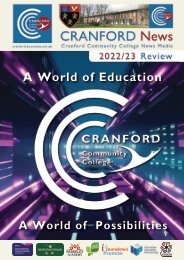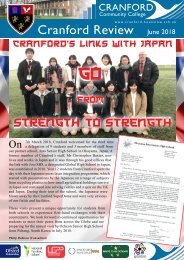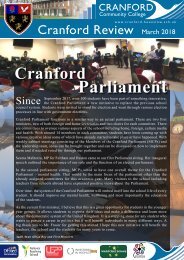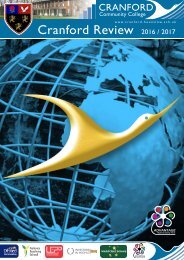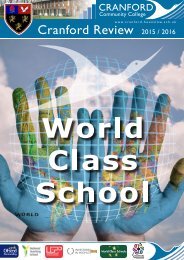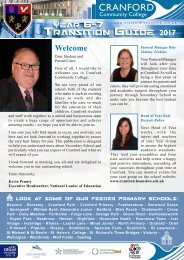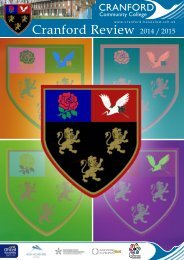Cranford Review 2019
The “Cranford Review” © is a publication of Cranford Community College. Is an annual high standard produced magazine which provides an archive document highlighting various aspects of the life of the academy, its staff, students and community from each academic year. It is a wonderful read and a useful historical document which, with its termly sister publications and occasional special editions, also serves to describe the values of the academy and support the aspirations of the academy, its staff, students and wider community. A colorful layout with a wide range of topics comprising events, extracurricular activities, recognition awards, initiatives, trips and excursions among many others. Hard copies are provided to stakeholders including families, staff, partners, visitors, prospective parents/students, prospective employees and others with an interest or stake in the academy and its students. Headteacher & Director: Kevin Prunty / Editor-in-chief: Jessica Joyce / Graphic Design: Enzo Gianvittorio Danese (Enzo GD) / Printed by: Springfieldpapers.com
The “Cranford Review” © is a publication of Cranford Community College. Is an annual high standard produced magazine which provides an archive document highlighting various aspects of the life of the academy, its staff, students and community from each academic year.
It is a wonderful read and a useful historical document which, with its termly sister publications and occasional special editions, also serves to describe the values of the academy and support the aspirations of the academy, its staff, students and wider community. A colorful layout with a wide range of topics comprising events, extracurricular activities, recognition awards, initiatives, trips and excursions among many others. Hard copies are provided to stakeholders including families, staff, partners, visitors, prospective parents/students, prospective employees and others with an interest or stake in the academy and its students.
Headteacher & Director: Kevin Prunty / Editor-in-chief: Jessica Joyce / Graphic Design: Enzo Gianvittorio Danese (Enzo GD) / Printed by: Springfieldpapers.com
Create successful ePaper yourself
Turn your PDF publications into a flip-book with our unique Google optimized e-Paper software.
A Christmas Carol<br />
On<br />
Wednesday 5th December 2018, the English<br />
Department invited Ginficent’s performance of A<br />
Christmas Carol to <strong>Cranford</strong> Community College – the second<br />
year in a row.<br />
Throughout the Autumn term, year 8 students had been studying<br />
the timeless tale of Ebeneezer Scrooge and the many ghosts<br />
of Christmas. It was a chilly, cloudy day, perfectly setting the<br />
tone for the tale to be told as part of a live performance. The<br />
students, a little unsure of what to expect at first, left the show<br />
feeling happy and satisfied with what they saw. They loved<br />
that the actors performed the characters with such zeal and<br />
added humour to the show to really showcase what the spirit of<br />
Christmas is all about. It was an interactive performance which<br />
brightened the day and really did help emphasise the need for<br />
dramatic performances of texts. Here is just one example of<br />
how year 8 responded to the book and the performance.<br />
Sahrish Shaikh (English Department)<br />
In “A Christmas Carol”, the social hierarchy<br />
is presented with the upper class having more<br />
wealth and power as the lower class lived in<br />
poverty. The wealthy (Scrooge) are shown<br />
as mean, cold-hearted people as they have<br />
no respect for the lower classes. Scrooge is<br />
also mean to his own nephew who is rich<br />
and loves Christmas, Fred is wealthy, but<br />
Scrooge is wealthier. Charles Dickens is<br />
trying to send a didactic message to the rich<br />
in Victorian London.<br />
A Christmas Carol is a good book. I also<br />
thought the storyline was interesting and<br />
unique. At the start, Charles Dickens<br />
presents Scrooge as a cold hearted and bitter<br />
character. When he is visited by the three<br />
spirits he starts to change as he sees his<br />
happy but also sad school life when he was<br />
poor and isolated. At the end he is jolly and<br />
happy and very charitable. We don’t think<br />
A Christmas Carol is a good book for the<br />
society we live in today. It mostly suits the<br />
Victorian era, as the upper class did not care<br />
for the working class. The message from the<br />
book was to be grateful for what you have<br />
and be charitable. The part that I like the<br />
most was at the end when Scrooge changed<br />
and is happy and charitable.<br />
The play of ‘A Christmas Carol’ was very<br />
good. We loved it as we could see what it<br />
was like in a Victorian house and the place<br />
where Scrooge worked. We also wanted to<br />
see how he talked to his worker and the<br />
people who needed to pay Scrooge and when<br />
he died, seeing his future. The actors did a<br />
good job taking the roles of lots of different<br />
characters. The person who played Scrooge<br />
did a brilliant job – he was very funny. The<br />
part we liked the most was when Scrooge<br />
changed and when he was jolly; it was<br />
quite funny when you could see him shaking<br />
everyone’s hands in the audience wishing<br />
them a “Merry Christmas and a Happy New<br />
Year!”<br />
The saddest part of the play which was even<br />
in the book was when tiny Tim died and<br />
Scrooge felt sympathy for him. We think<br />
it was an important turning point for his<br />
character in the play and the text itself.<br />
44<br />
Taseen Ismail, Rosy Mustaffa, Jagveer Kang<br />
& Zohaib Butt (year 8)




